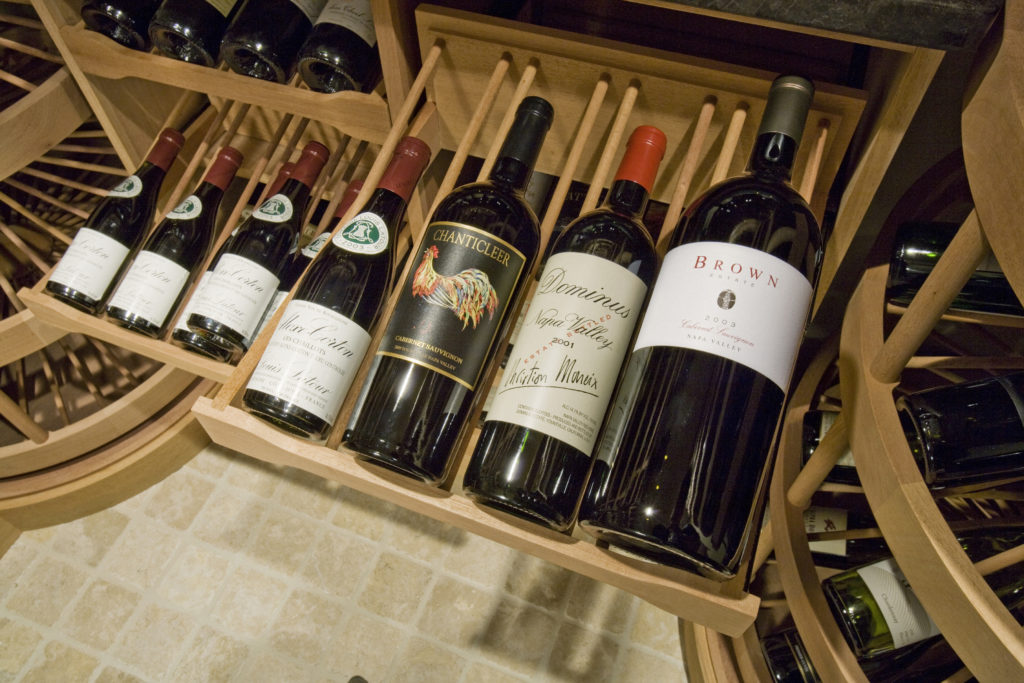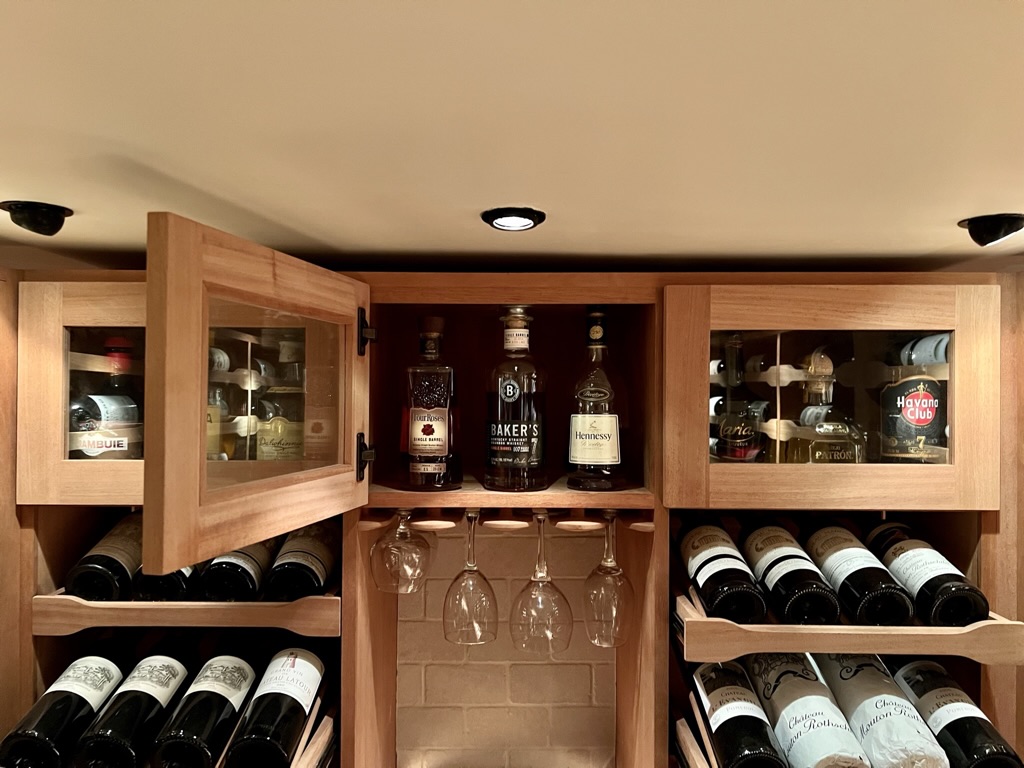
This is what we call our flagship cellar. I created it for myself and my collection 15 years ago. My sole focus was to make a cellar that worked for me – focusing on function over aesthetics.
Much to my surprise, people thought my little cellar was visually compelling. I even started to get requests from other collectors to help them with their cellar designs. It got to a point where I decided to form Revel and go into business.
Being a collector for many years gave me the perspective to look at new ways to think about wine cellars and how they function.
My goal was to create the simplest and most effective way to enjoy my collecting passion. Designers often start with an aesthetic goal, and back into the wine itself. I needed to turn that concept on its head and start with the wine and back into everything else. Form follows function.
People often refer to me as a wine cellar designer. I started Revel with no training or education in design. I prefer to consider myself to be a creative problem solver. Here are some problems I encountered with that very first cellar, along with ways I found to solve them.
Goals
- Small space, but capacity was very important – needed 700 bottles;
- Needed space for 15 wood cases;
- Needed storage to accommodate every size and shape of bottle;
- Needed to see the bottles and read the labels;
- Lighting built into the cabinetry was critical;
- Needed prominent displays for important bottles;
- Wanted space for some special whiskeys and tequilas;
- Wanted to have a place to keep some wine glasses so I could open a bottle and pour a couple glasses;
- Wanted some counter area for odd sized boxes and other “stuff”;
- Needed efficiency – in energy use, in space use, in functionality;
- Wanted to eliminate wasted space in corners;
- Wanted durable, organic, hard surfaces, mold resistant materials, and efficient energy systems for cooling.
The Space
The space I had for my cellar was a 7’ x 9’ basement pantry. This is not much space for a collection of 700 bottles. I knew to make this space work, efficiency and functionality were key. This meant I had to get creative when approaching my design, and wasting space was not an option.
Wine Case Storage
Like many collectors, I often order wine by the case. The traditional wine racking doesn’t offer anywhere to store them, and I didn’t want them to be blocking any of my other bottles or taking up counter space.
Oftentimes, the original wood boxes that many collectable wines come in are beautiful to display, and they also help to preserve the value of the wine. To solve this problem, I designed sliding pullout drawers to fit nearly all case sizes so that they weren’t in the way, but I could still get to them easily.

Accommodating Various Bottle Shapes & Sizes
As any collector would know, wine bottles come in different shapes and sizes. Many of these various shapes and sizes will not fit into a typical wine rack “slot”, such as Champagnes. Rather than building multiple different systems for these different formats, I deliberately designed all of our systems to accommodate everything from a 375 ml to a magnum, and completely eliminated that problem.

Wine Bottle & Label Visibility
This was one of the most critical issues for me when taking the design into my own hands. With traditional wine racking with the “cork out” method, you had no way of seeing your labels without taking each individual bottle out to look at it. My solution to this was sliding pull out wine drawers that orient the bottles on their sides, with the label facing out. With this design, I could access any wine in my cellar with one smooth motion, without ever disturbing another bottle.

Wine Cellar Lighting
Any collector knows that light is not generally good for wine, but of course you need to be able to see your bottles. I wanted a system that incorporated lighting in a way that uses as little energy and heat as possible. By using low voltage LED lighting built into the backs of the cabinets using a dimmer, I got the visibility I needed, and it lasts almost forever while doing no damage to the wine.

Specialized displays for important bottles
When you have been collecting wine for as many years as I have, chances are you’ve got some bottles that are worth showing off. They deserve to be the center of attention, not hidden away where nobody can see them.

Storage space for liquors
For those of us who do not exclusively drink wine, I also wanted to incorporate some storage space for some of my premium liquors. When entertaining or looking for a night cap, sometimes a nice bourbon just hits the spot. These liquors are also best stored in a cool, temperature controlled environment, similar to wine.

Space to open a bottle and pour a glass
Although nobody wants to drink wine in a cold cellar, it is the perfect place to select a bottle and pour a glass or two as you admire your collection. For this reason, it was important for me to incorporate space to hold glasses and a bottle opener that didn’t look messy or out of place.

Counter space
In a similar vein, it is inevitable that you might have some boxes or other oddly shaped items that you will want to keep in your cellar. Wine boxes come in all different shapes and sizes depending on what and how much you order, so it was important to me to have some counter space available to accommodate these or any other miscellaneous objects I might want in my cellar.

All-Around Efficiency
Given what I had to work with, efficiency was crucial, in every sense. Every space would be utilized in a way that maximized bottle count, while still ensuring there would be enough circulation space and without overcrowding.
For energy efficiency, I incorporated motion detection LED lights, and used a fully ducted cooling system.
Wasted space in corners
To get the capacity I wanted out of my small space, I knew I had to find a way to utilize that corner space that gets wasted in traditional racking systems. I took a note from a space-saving concept that I had in my kitchen cabinetry and adapted it to work for wine. This resulted in what we now call the Wine Wheel. This feature optimizes storage capacity by utilizing otherwise wasted corner space.

Durable Materials
It goes without saying that the materials you use to construct your wine cellar matter. For the integrity of the structure, a durable material is a requirement, as is a material that can stand the climate conditions without the risk of mold. And of course, a material that will aesthetically complement the space is preferable. For my cellar, this would be hand-crafted Mahogany.

When it all comes together, the result just so happens to be visually stunning. I encourage you to check out some of the wine cellars on our website to see how our systems can accommodate a wide array of styles.
To me, it’s a simple matter of form following function. That original plan still speaks today to what I think are the essential considerations of a wine cellar designed for the needs of the collector.
We judge our own success by how well our designs meet the goals and requirements of our customers. We try to do that with innovation, well engineered systems using clean lines and quality materials.
